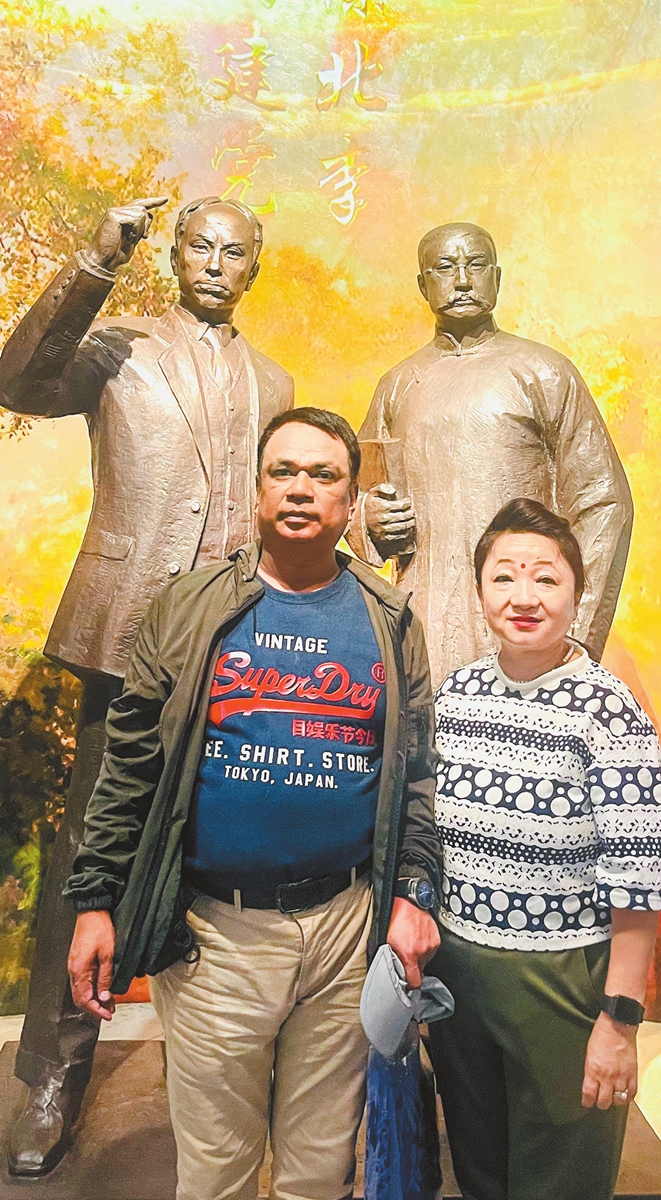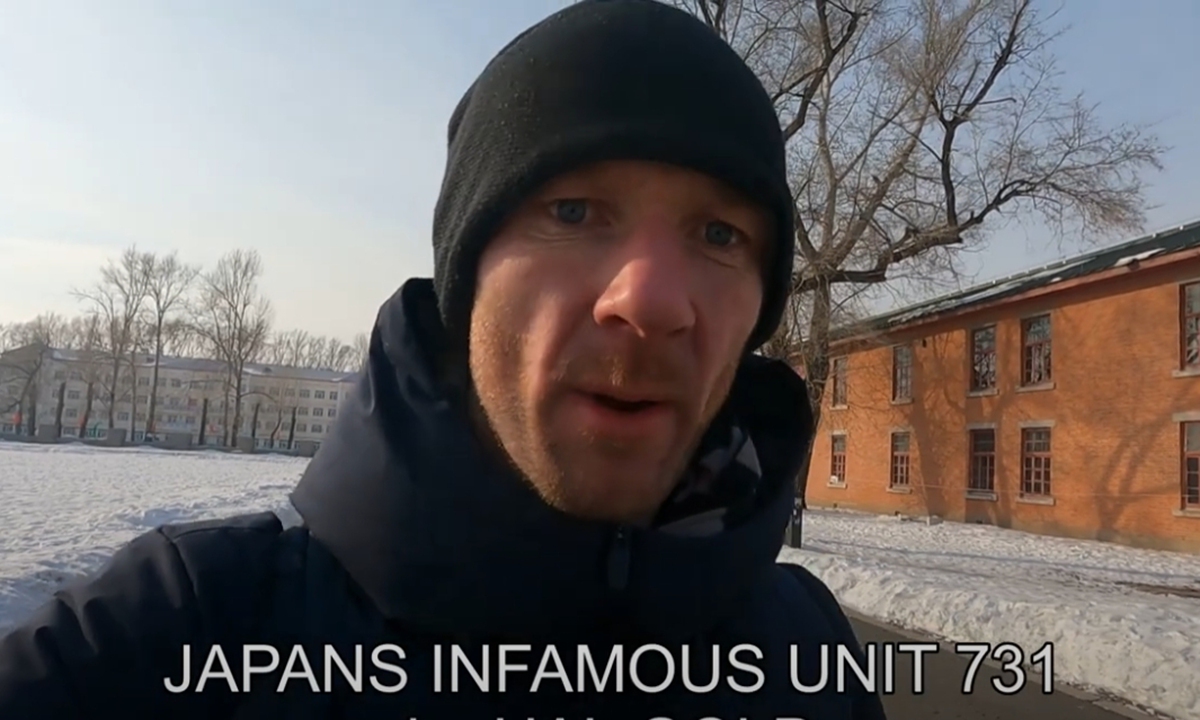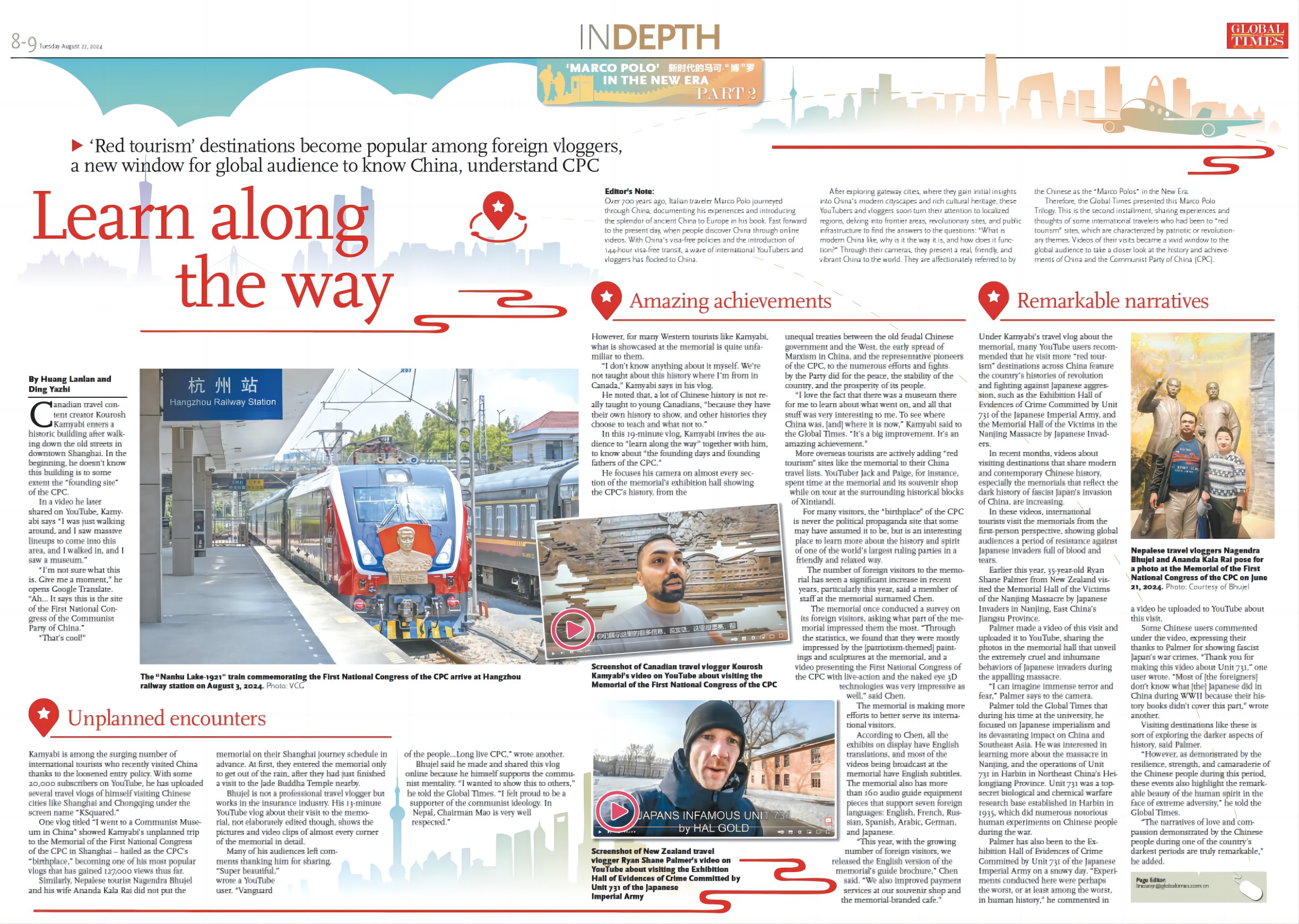RECENT POSTS
Red tourism’ destinations become popular among foreign vloggers, a new window for global audience to know China, understand CPC...? | MUNIPALLI AKSHAY PAUL |
‘Red tourism’ destinations become popular among foreign vloggers, a new window for global audience to know China, understand CPC
Huang Lanlan and Ding Yazhi
19:30 Aug 26 2024
19:30 Aug 26 2024
The "Nanhu Lake·1921" train commemorating the First National Congress of the CPC arrive at Hangzhou railway station on August 3, 2024. Photo: VCG
Editor's Note:Over 700 years ago, Italian traveler Marco Polo journeyed through China, documenting his experiences and introducing the splendor of ancient China to Europe in his book. Fast forward to the present day, when people discover China through online videos. With China's visa-free policies and the introduction of 144-hour visa-free transit, a wave of international YouTubers and vloggers has flocked to China.
After exploring gateway cities, where they gain initial insights into China's modern cityscapes and rich cultural heritage, these YouTubers and vloggers soon turn their attention to localized regions, delving into frontier areas, revolutionary sites, and public infrastructure to find the answers to the questions: "What is modern China like, why is it the way it is, and how does it function?" Through their cameras, they present a real, friendly, and vibrant China to the world. They are affectionately referred to by the Chinese as the "Marco Polos" in the New Era.
Therefore, the Global Times presented this Marco Polo Trilogy. This is the second installment, sharing experiences and thoughts of some international travelers who had been to "red tourism" sites, which are characterized by patriotic or revolutionary themes. Videos of their visits became a vivid window to the global audience to take a closer look at the history and achievements of China and the Communist Party of China (CPC).
Canadian travel content creator Kourosh Kamyabi enters a historic building after walking down the old streets in downtown Shanghai. In the beginning, he doesn't know this building is to some extent the "founding site" of the CPC.
In a video he later shared on YouTube, Kamyabi says "I was just walking around, and I saw massive lineups to come into this area, and I walked in, and I saw a museum."
"I'm not sure what this is. Give me a moment," he opens Google Translate. "Ah... It says this is the site of the First National Congress of the Communist Party of China."
"That's cool!"
Unplanned encounters
Kamyabi is among the surging number of international tourists who recently visited China thanks to the loosened entry policy. With some 20,000 subscribers on YouTube, he has uploaded several travel vlogs of himself visiting Chinese cities like Shanghai and Chongqing under the screen name "KSquared."
One vlog titled "I went to a Communist Museum in China" showed Kamyabi's unplanned trip to the Memorial of the First National Congress of the CPC in Shanghai - hailed as the CPC's "birthplace," becoming one of his most popular vlogs that has gained 127,000 views thus far.
Similarly, Nepalese tourist Nagendra Bhujel and his wife Ananda Kala Rai did not put the memorial on their Shanghai journey schedule in advance. At first, they entered the memorial only to get out of the rain, after they had just finished a visit to the Jade Buddha Temple nearby.
Bhujel is not a professional travel vlogger but works in the insurance industry. His 13-minute YouTube vlog about their visit to the memorial, not elaborately edited though, shows the pictures and video clips of almost every corner of the memorial in detail.
Many of his audiences left comments thanking him for sharing. "Super beautiful," wrote a YouTube user. "Vanguard of the people...Long live CPC," wrote another.
Bhujel said he made and shared this vlog online because he himself supports the communist mentality. "I wanted to show this to others," he told the Global Times. "I felt proud to be a supporter of the communist ideology. In Nepal, Chairman Mao is very well respected."

Nepalese travel vloggers Nagendra Bhujel and Ananda Kala Rai pose for a photo at the Memorial of the First National Congress of the CPC on June 21, 2024. Photo: Courtesy of Bhujel
Amazing achievementsHowever, for many Western tourists like Kamyabi, what is showcased at the memorial is quite unfamiliar to them.
"I don't know anything about it myself. We're not taught about this history where I'm from in Canada," Kamyabi says in his vlog.
He noted that, a lot of Chinese history is not really taught to young Canadians, "because they have their own history to show, and other histories they choose to teach and what not to."
In this 19-minute vlog, Kamyabi invites the audience to "learn along the way" together with him, to know about "the founding days and founding fathers of the CPC."
He focuses his camera on almost every section of the memorial's exhibition hall showing the CPC's history, from the unequal treaties between the old feudal Chinese government and the West, the early spread of Marxism in China, and the representative pioneers of the CPC, to the numerous efforts and fights by the Party did for the peace, the stability of the country, and the prosperity of its people.
"I love the fact that there was a museum there for me to learn about what went on, and all that stuff was very interesting to me. To see where China was, [and] where it is now," Kamyabi said to the Global Times. "It's a big improvement. It's an amazing achievement."
More overseas tourists are actively adding "red tourism" sites like the memorial to their China travel lists. YouTuber Jack and Paige, for instance, spent time at the memorial and its souvenir shop while on tour at the surrounding historical blocks of Xintiandi.
For many visitors, the "birthplace" of the CPC is never the political propaganda site that some may have assumed it to be, but is an interesting place to learn more about the history and spirit of one of the world's largest ruling parties in a friendly and relaxed way.
The number of foreign visitors to the memorial has seen a significant increase in recent years, particularly this year, said a member of staff at the memorial surnamed Chen.
The memorial once conducted a survey on its foreign visitors, asking what part of the memorial impressed them the most. "Through the statistics, we found that they were mostly impressed by the [patriotism-themed] paintings and sculptures at the memorial, and a video presenting the First National Congress of the CPC with live-action and the naked eye 3D technologies was very impressive as well," said Chen.
The memorial is making more efforts to better serve its international visitors.
According to Chen, all the exhibits on display have English translations, and most of the videos being broadcast at the memorial have English subtitles. The memorial also has more than 160 audio guide equipment pieces that support seven foreign languages: English, French, Russian, Spanish, Arabic, German, and Japanese.
"This year, with the growing number of foreign visitors, we released the English version of the memorial's guide brochure," Chen said. "We also improved payment services at our souvenir shop and the memorial-branded cafe."
Remarkable narratives
Under Kamyabi's travel vlog about the memorial, many YouTube users recommended that he visit more "red tourism" destinations across China feature the country's histories of revolution and fighting against Japanese aggression, such as the Exhibition Hall of Evidences of Crime Committed by Unit 731 of the Japanese Imperial Army, and the Memorial Hall of the Victims in the Nanjing Massacre by Japanese Invaders.
In recent months, videos about visiting destinations that share modern and contemporary Chinese history, especially the memorials that reflect the dark history of fascist Japan's invasion of China, are increasing.
In these videos, international tourists visit the memorials from the first-person perspective, showing global audiences a period of resistance against Japanese invaders full of blood and tears.
Earlier this year, 35-year-old Ryan Shane Palmer from New Zealand visited the Memorial Hall of the Victims of the Nanjing Massacre by Japanese Invaders in Nanjing, East China's Jiangsu Province.
Palmer made a video of this visit and uploaded it to YouTube, sharing the photos in the memorial hall that unveil the extremely cruel and inhumane behaviors of Japanese invaders during the appalling massacre.
"I can imagine immense terror and fear," Palmer says to the camera.

Screenshot of New Zealand travel vlogger Ryan Shane Palmer's video on YouTube about visiting the Exhibition Hall of Evidences of Crime Committed by Unit 731 of the Japanese Imperial Army
Palmer told the Global Times that during his time at the university, he focused on Japanese imperialism and its devastating impact on China and Southeast Asia. He was interested in learning more about the massacre in Nanjing, and the operations of Unit 731 in Harbin in Northeast China's Heilongjiang Province. Unit 731 was a top-secret biological and chemical warfare research base established in Harbin in 1935, which did numerous notorious human experiments on Chinese people during the war.Palmer has also been to the Exhibition Hall of Evidences of Crime Committed by Unit 731 of the Japanese Imperial Army on a snowy day. "Experiments conducted here were perhaps the worst, or at least among the worst, in human history," he commented in a video he uploaded to YouTube about this visit.
Some Chinese users commented under the video, expressing their thanks to Palmer for showing fascist Japan's war crimes. "Thank you for making this video about Unit 731," one user wrote. "Most of [the foreigners] don't know what [the] Japanese did in China during WWII because their history books didn't cover this part," wrote another.
Visiting destinations like these is sort of exploring the darker aspects of history, said Palmer.
"However, as demonstrated by the resilience, strength, and camaraderie of the Chinese people during this period, these events also highlight the remarkable beauty of the human spirit in the face of extreme adversity," he told the Global Times.
"The narratives of love and compassion demonstrated by the Chinese people during one of the country's darkest periods are truly remarkable," he added.

Previous Post
« Prev Post
« Prev Post
Next Post
Next Post »
Next Post »
- Get link
- X
- Other Apps
RELATED POSTS
What is Economics..? Explain about it in a few words..? | MUNIPALLI AKSHAY PAUL |
Economics is the study of how societies, businesses, governments, and individuals make choices about allocating limited resources to satisfy their needs and wants. It examines the production, distribution, and consumption of goods and services and seeks to understand how people make decisions in various environments. Key Concepts in Economics: Scarcity Scarcity refers to the basic economic problem that resources (like time, money, labor, and materials) are limited, while human wants are unlimited. This forces individuals and societies to make choices about how to use these resources. Supply and Demand The law of supply and demand is a fundamental concept. It states that the price of a good or service is determined by the quantity available (supply) and the desire for it (demand). Higher demand with limited supply leads to higher prices, and vice versa. Opportunity Cost Opportunity cost is the cost of forgoing the next best alternative when making a decision. It helps to me...
Explain about belief in Static Abilities...? "munipalli akshay paul"
The belief in static abilities, often linked to a fixed mindset, is the idea that talents, intelligence, and skills are innate, unchanging, and determined at birth. People with this belief perceive their abilities as static traits rather than dynamic ones that can develop through effort, learning, and experience. This perspective influences their approach to challenges, feedback, and personal growth, often limiting their potential and resilience in the face of adversity. Key Features of the Belief in Static Abilities 1. Innate Talent Focus: People with this belief emphasize natural ability over effort, viewing intelligence, creativity, or other talents as predetermined. 2. Fear of Failure: Failure is seen as a reflection of one’s inherent limitations, leading to avoidance of challenges where success isn’t guaranteed. 3. Resistance to Feedback: Feedback is often taken personally, as it’s perceived as a critique of unchangeable traits rather than an opportunity to improve. 4. Comparative...
What is Compound interest..? Explain a few lines of words..? | MUNIPALLI AKSHAY PAUL |
Compound Interest is a financial concept where the interest earned on a principal amount also earns interest over time. This process of earning "interest on interest" accelerates the growth of an investment or loan compared to simple interest, where only the principal earns interest. Formula for Compound Interest The formula to calculate compound interest is: \[ A = P \times (1 + \frac{r}{n})^{n \cdot t} \] Where: - A = Total amount (principal + interest). - P = Principal amount (initial sum of money). - r = Annual interest rate (in decimal form). - n = Number of times the interest is compounded per year. - t = Time (in years). The compound interest is then calculated as: \[ CI = A - P \] Key Features of Compound Interest 1. Exponential Growth Compound interest grows exponentially because interest is calculated on an increasing amou...
Explain about closed mindset...? "munipalli akshay paul"
A closed mindset is a psychological state where an individual resists change, avoids new ideas, and rejects alternative perspectives. It is the opposite of a growth mindset, which encourages learning, adaptability, and curiosity. A closed mindset can significantly impact personal growth, relationships, and professional development, as it often limits opportunities for improvement and hinders effective problem-solving. Characteristics of a Closed Mindset 1. Resistance to Change: People with a closed mindset fear change, as it challenges their existing beliefs or routines. They prefer to stick to familiar methods and avoid stepping out of their comfort zones. 2. Fixed Beliefs: They hold rigid beliefs and are unwilling to question them. This stubbornness can lead to a lack of critical thinking and a failure to adapt to new situations or evidence. 3. Fear of Failure: A closed mindset is often accompanied by a fear of failure. Such individuals may avoid risks or new challenges because they ...
What is a Company..? Explain about it in a few words..? | MUNIPALLI AKSHAY PAUL |
A company is a legal entity formed by a group of individuals to engage in and operate a business enterprise. Companies exist to produce goods or provide services to consumers, earn profits, and contribute to economic growth. They are structured to achieve specific objectives and are governed by laws and regulations that vary by jurisdiction. Types of Companies Companies can be categorized based on their ownership, structure, and purpose: 1. Private Companies: These are privately held and typically have fewer shareholders. Their shares are not available to the public. Examples include small businesses and startups. 2. Public Companies: These are listed on stock exchanges, allowing the public to buy and sell shares. They are subject to stricter regulations to ensure transparency. 3. Non-Profit Companies: These organizations are formed not to generate profits but to serve a public or community purpose, such as charities or foundations. 4. Government-Owned Companies: These are entitie...
.jpeg)
.jpeg)
.jpeg)
Comments
Post a Comment